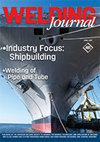Analysis of a High-Strength Steel SMAW Database
IF 1.4
3区 材料科学
Q2 METALLURGY & METALLURGICAL ENGINEERING
引用次数: 4
Abstract
Recently, Dr. Glyn M. Evans posted a large shielded metal arc (SMA) weld metal (WM) database on the ResearchGate website (researchgate.net). This database contains more than 950 WM compositions, along with their respective WM tensile and Charpy V-notch (CVN) impact properties. In particular, the CVN impact properties list the test temperatures that achieved 28 and 100 J impact energy for each WM composition. While the availability of this SMA WM database is a valuable and rare gift to the welding community, how could the welding community analyze this database to gain valuable insights? This paper utilizes a constraints-based model (CBM) as a simple and effective framework to organize and analyze this very large Fe-C-Mn SMA WM database. A CBM is built on the metallurgical principle that one needs to lower relevant solid-state phase transformation (i.e., austenite decomposition) temperatures to improve WM strength and fracture toughness while simultaneously reducing carbon content and Yurioka’s carbon equivalent number (CEN) to improve the weldability of high-strength steels. To this end, a CBM identifies and simultaneously solves several statistical (regression) equations that relate the chemical composition of high-strength steel WM with Yurioka’s CEN and selected solid-state phase transformation temperatures related to austenite decomposition. The results of the current effort demonstrate that the analysis of Evans’s shielded metal arc welding database using a CBM as a framework reaffirms that controlling carbon content, the value of the CEN, and calculated solid-state phase transformation temperatures, particularly the difference between the calculated Bs (bainite-start) and Ms (martensite-start) temperatures, is critical to developing and identifying high-performance, high-strength steel welding electrodes. A dual approach that manipulates the contents of principal alloy elements such as C, Mn, Ni, Cr, Mo, and Cu, and adds controlled amounts of Ti, B, Al, O, and N, appears to offer the best means to lower relevant solid-state phase transformation temperatures to produce high-strength and high-toughness WMs.高强度钢SMAW数据库的分析
最近,Glyn M. Evans博士在ResearchGate网站(researchgate.net)上发布了一个大型屏蔽金属电弧(SMA)焊接金属(WM)数据库。该数据库包含950多种WM成分,以及它们各自的WM拉伸和夏比v型缺口(CVN)冲击性能。特别是,CVN冲击性能列出了每种WM成分达到28和100 J冲击能量的测试温度。虽然这个SMA WM数据库的可用性对焊接界来说是一个宝贵而罕见的礼物,但焊接界如何分析这个数据库以获得有价值的见解呢?本文利用基于约束的模型(CBM)作为一个简单有效的框架来组织和分析这个非常大的Fe-C-Mn SMA WM数据库。CBM建立在冶金原理的基础上,即需要降低相关的固相转变(即奥氏体分解)温度,以提高WM强度和断裂韧性,同时降低碳含量和Yurioka碳当量数(CEN),以提高高强度钢的可焊性。为此,CBM识别并同时求解了几个统计(回归)方程,这些方程将高强度钢WM的化学成分与Yurioka的CEN和与奥氏体分解相关的选定固相转变温度联系起来。目前的研究结果表明,使用CBM作为框架对Evans的屏蔽金属电弧焊数据库进行的分析再次表明,控制碳含量、CEN值和计算的固态相变温度,特别是计算的Bs(贝氏体开始)和Ms(马氏体开始)温度之间的差异,对于开发和确定高性能、高强度钢焊条至关重要。控制主要合金元素(如C、Mn、Ni、Cr、Mo和Cu)的含量,并添加一定量的Ti、B、Al、O和N的双重方法,似乎是降低相关固相转变温度以生产高强度和高韧性WMs的最佳方法。
本文章由计算机程序翻译,如有差异,请以英文原文为准。
求助全文
约1分钟内获得全文
求助全文
来源期刊

Welding Journal
工程技术-冶金工程
CiteScore
3.00
自引率
0.00%
发文量
23
审稿时长
3 months
期刊介绍:
The Welding Journal has been published continually since 1922 — an unmatched link to all issues and advancements concerning metal fabrication and construction.
Each month the Welding Journal delivers news of the welding and metal fabricating industry. Stay informed on the latest products, trends, technology and events via in-depth articles, full-color photos and illustrations, and timely, cost-saving advice. Also featured are articles and supplements on related activities, such as testing and inspection, maintenance and repair, design, training, personal safety, and brazing and soldering.
 求助内容:
求助内容: 应助结果提醒方式:
应助结果提醒方式:


